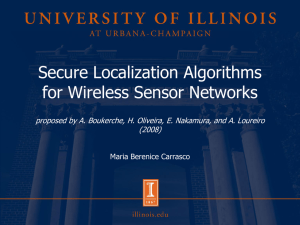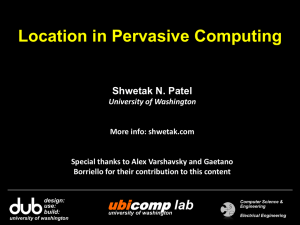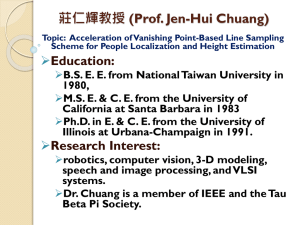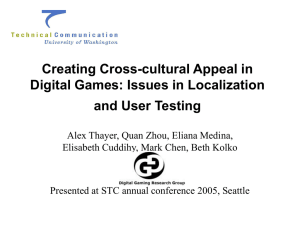Final Presentation
advertisement
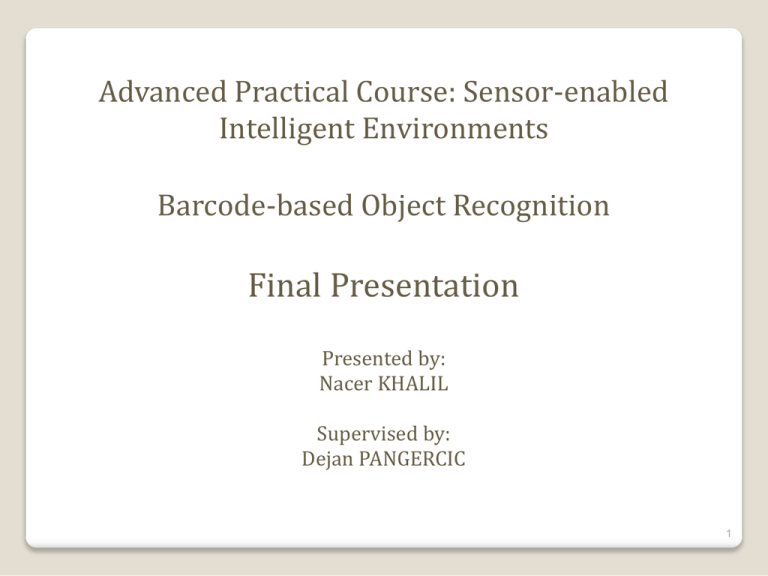
Advanced Practical Course: Sensor-enabled Intelligent Environments Barcode-based Object Recognition Final Presentation Presented by: Nacer KHALIL Supervised by: Dejan PANGERCIC 1 Table of content I- Overall project goal II- Autofocus III- Bacode decoding IV- information retrieval V- Barcode localization VI- Conclusion 2 II-Autofocus How autofocus works Active vs passive autofocus Courtesy of howstuffworks.com 3 II-Autofocus (continued) 4 II- Autofocus Implementation in the project Used camera: Logitech QC PRO 9000 Driver used: ROS::uvc_camera Problem: Autofocus is not supported by the driver Solution: Autofocus was added to uvc_camera driver Autofocus algorithm was taken from GUVCVIEW software and integrated within uvc_camera driver 5 II- Autofocus result 6 III-Barcode decoding How Zbar works 12 10 8 Column 1 Column 2 Column 3 6 4 2 0 Row 1 Courtesy of Jeff Brown Row 2 Row 3 Row 4 7 IV-Information retrieval Barcoo is a product information store that has a database composed of 7 million commercial objects. Access to this database was granted to us. Communication to the database is done through HTTP protocol. Request: an http link containing the barcode Response: XML file containing all information about the object http://www.barcoo.com 8 IV- Information retrieval Barcoo request response example Request: http://www.barcoo.com/api/get_product_complete? Pi=73705207908 &pins=ean&amp ;format=xml&source=ias-tum Response: We are parsing for: - Image - product name - category - producer 9 V- Barcode localization Techniques used Techniques used to find the barcode region of interest – Blob-based barcode localization – Parallel line-based localization – Adjacent line-based localization 10 V- Barcode localization Blob-based localization(working example) 11 V- Barcode localization Blob-based localization (not working example) 12 V- Barcode localization Adjacent line-based localization 13 V-Barcode localization How adjacent line-based localization works Take picture Picture fragmentation Elimination of inacceptable intervals Computation of jeffries distances Selection of best ROI 14 V-Barcode localization Adjacent line-based approach explanation - Take picture - Convert to grayscale - Parameters: interval size, min/max # of transitions, max Jeffrie’s value, min # of rows per ROI Image matrix Transitions matrix Eliminated intervals 255 15 56 54 84 165 75 0 250 20 60 84 120 0 240 97 248 18 61 0 13 51 15 85 246 17 55 70 55 52 0 200 1 0 2 2 2 2 1 0 1 2 2 2 1 0 2 1 2 2 1 0 2 1 2 2 1 0 -1 -1 -1 -1 1 0 1 -1 -1 -1 1 0 -1 1 -1 -1 1 0 -1 1 -1 -1 15 V-Barcode localization Adjacent line-based approach explanation (continued) Jeffrie ’s distance matrix Eliminated intervals matrix Final matrix 0,2 1 5,2 8,4 5,3 1,3 1,2 2 2,4 2,4 6,7 1 0,5 1 3,2 0,1 8,4 2,4 1 0 -1 -1 -1 -1 1 0 1 -1 -1 -1 1 0 -1 1 -1 -1 1 0 -1 1 -1 -1 0,2 1 -1 -1 -1 -1 1,2 2 0 -1 -1 -1 0,5 1 -1 0,1 -1 -1 16 IV- Barcode localization Adjacent line-based localization - results 17 Open Source Code Packages list: - zbar_barcode_reader_node - zbar_qt_ros - uvc_camera - barcode_detection Repositories: - http://code.cs.tum.edu/indefero/index.php//p/seie2011fall/source/tree/HEAD/kh alil - http://code.cs.tum.edu/indefero/index.php//p/ias-perception/source/tree/master/ 18 Conclusion Project is composed of three parts: Barcode localization Implementation of autofocus Information retrieval of objects Future work: Creation of the barcoo ontology and storage on KnowRob Integration and testing on PR2 Integration with object modeling center 19 Demonstrations of the project in the kitchen lab after the presentations end 20
